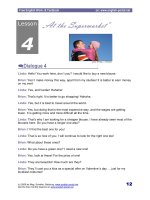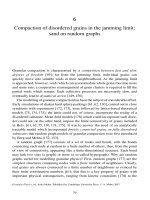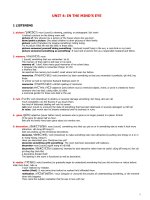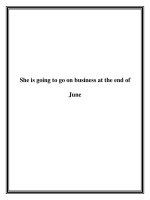4 15 the show must go on
Bạn đang xem bản rút gọn của tài liệu. Xem và tải ngay bản đầy đủ của tài liệu tại đây (2.62 MB, 10 trang )
Fascinating Facts
• A Frenchman named Louis Lumière (lwee
The Show
Must Go On!
lyoom-YEHR) invented the movie camera in
1895. One of his first movies showed a train
arriving in Lyons, France.
• “The Golden Age of Radio” lasted from the
1920s to the 1950s. Radio programs during
this time were diverse, entertaining, and
very popular.
• The first televisions had black-and-white
pictures. In 1954 color came to television.
Genre
Nonfiction
Comprehension Skill
Draw Conclusions
Text Features
• Captions
• Table of Contents
Scott Foresman Social Studies
ISBN 0-328-14867-9
ì<(sk$m)=beigh < +^-Ä-U-Ä-U
by
KRISTIN CASHORE
During the 1900s entertainment in the
United States grew and changed. In this book
you will read about movies, radio, musicals,
and television and their place in the history
of entertainment.
Vocabulary
industry
profitable
vaudeville
diverse
hub
production
Table of Contents
Looking for Fun...................................page 2
Write to It!
This book did not discuss every kind of
entertainment in the United States. For
example, it did not mention reading. Think
of a book that has entertained you. Write
one paragraph about this book. Explain
why you find the book entertaining. Give
examples.
The Show
Must Go On!
Write your paragraph on a separate sheet
of paper.
Vaudeville............................................page 4
The Movies..........................................page 6
Radio...................................................page 8
Broadway Musicals............................page 10
The Movies Meet Television...............page 12
Reaching New Audiences..................page 14
by KRISTIN CASHORE
ISBN: 0-328-14867-9
Copyright © Pearson Education, Inc. All Rights Reserved. Printed in the United
States of America. This publication is protected by Copyright, and permission should be
obtained from the publisher prior to any prohibited reproduction, storage in a retrieval
system, or transmission in any form by any means, electronic, mechanical, photocopying,
recording, or likewise. For information regarding permission(s), write to: Permissions
Department, Scott Foresman, 1900 East Lake Avenue, Glenview, Illinois 60025.
1 2 3 4 5 6 7 8 9 10 V0G1 14 13 12 11 10 09 08 07 06 05
Photographs
Every effort has been made to secure permission and provide appropriate credit for photographic material.
Editorial Offices: Glenview, Illinois • Parsippany, New Jersey • New York, New York
The publisher deeply regrets any omission and pledges to correct errors called to its attention in subsequent editions.
Sales Offices:
Needham,
• Duluth,a Georgia
Glenview,
Illinois
Unless otherwise acknowledged,
all photographs
are theMassachusetts
property of Scott Foresman,
division of•Pearson
Education.
Texas
• Sacramento,
California
• Mesa,
Arizona (Bkgd).
Photo locators denoted asCoppell,
follows: Top
(T), Center
(C), Bottom (B),
Left (L), Right
(R), Background
Page Number ©Company,
Looking for Fun
People in the United States have always loved
entertainment. At the beginning of the 1900s, people all
over the country found fun things to do. A family in New
York City might spend a day at the amusement parks
on Coney Island. A family in Chicago might go to the
ballpark to cheer for the local baseball team. Circuses
traveled the country by train. People knew they were
going to have fun whenever the circus was in town!
The circus was popular in many towns.
The entertainment industry in the United States
was just beginning to grow. Movies became popular.
Broadway musicals became popular first in New York
City and spread later to other towns. The radio and the
television were invented.
How did entertainment grow and change? One of the
first steps toward this growth was called vaudeville
(VAWD-vill).
In the early 1900s millions of people visited Coney Island
in Brooklyn, New York.
2
3
Vaudeville
In the early 1900s vaudeville was very popular in the
United States. A vaudeville show was a stage show with
many short acts. One act usually did not have anything
to do with another. For example, a dancing act might
come before or after an act with animal tricks. A magic
act might come next. Vaudeville shows played in the large
cities. They also toured through the small towns.
This Broadway theater in New York City featured
vaudeville performances.
Vaudeville performers were dancers, singers, and
people with special talents. Some vaudeville performers
became huge stars. The most famous vaudeville shows
took place at the Palace Theater in New York City.
Vaudeville is important in the history of entertainment.
Most other kinds of entertainment in the United States
grew from vaudeville.
This vaudeville performer is a strong man. He can balance
two people with his mouth.
4
5
The Movies
During the 1910s and 1920s, movies became popular.
The first movies were silent and had no talking or sound
effects. Charlie Chaplin and Mary Pickford were big silent
movie stars.
Hollywood, California, had nice weather and lots of
sunlight. This was a good location for making movies, so
Hollywood became the hub of moviemaking. Studios,
or companies that made movies, became very wealthy.
Moviemaking was a very profitable business and made
a lot of money.
The movie It Happened One Night, starring Clark Gable
and Claudette Colbert, was very popular in 1934.
In the late 1920s inventors figured out how to add
sound to movies. The first movies with sound were called
“talkies.” The movie studios began to make talkies, and
audiences loved them! Moviemaking became even more
profitable for the studios.
Because movies were so popular, vaudeville began to
die out. In 1932 even New York’s Palace Theater stopped
showing vaudeville. It began to show movies instead.
Charlie Chaplin is
famous for his silent
movies.
6
7
Radio
In the 1920s radio became popular. The first radio
shows were a lot like vaudeville. They had short acts with
music or comedy.
By the middle of the 1930s, however, radio had
become more like the movies. It was a place for telling
stories. There were science fiction radio shows and
Westerns. There were mysteries, adventures, and
comedies. There were even radio versions of Hollywood
movies.
The first radios were very large.
During the 1930s and World War II, President Franklin D. Roosevelt spoke
to people over the radio. He talked about what was happening in the
country and all around the world.
Radio entertainment became more and more diverse.
Comedians made audiences laugh. Radio characters, such
as the Lone Ranger, the Shadow, and the Green Hornet,
stopped crime. Many people listened to soap operas on
the radio.
By 1939 about 80 percent of the families in the United
States had radios. News was reported live on the radio.
President Franklin D. Roosevelt gave radio talks called
“fireside chats.” Radio connected people with the rest of
the world.
8
9
Broadway Musicals
Before 1927 most musical shows on Broadway had
lots of dancing and singing. Like vaudeville, however,
these big productions did not tell much of a story. A
production is something created with the work of many
people and involving many different parts. In 1927 a
musical called Showboat changed this.
Showboat was a musical play. It had a story line.
Its characters had depth. The musical numbers were
connected by a plot. Showboat told a story.
Showboat changed Broadway musicals. By the 1940s
the themes and plots of Broadway musicals were rich.
The characters were
complicated. Some of
the big hits of the 1940s
were Oklahoma!,
Carousel, and South
Pacific.
In the 1930s and 1940s, Fred Astaire and Ginger
Rogers danced in Hollywood musicals.
Movie studios in Hollywood also began to make
musicals. Singers Judy Garland and Gene Kelly and
dancers Fred Astaire and Ginger Rogers lit up the silver
screen. Musicals had found their place in American
entertainment.
In 1927 Showboat changed
Broadway musicals forever.
10
11
The Movies Meet Television
In the 1940s and 1950s, Hollywood was at its peak.
Humphrey Bogart, Katharine Hepburn, and Jimmy Stewart
were some of the big stars. A man named Walt Disney
began to make animated movies, starting with Fantasia in
1940.
In 1941 Orson Welles directed the movie Citizen
Kane. Just as Showboat changed musicals, Citizen Kane
changed movies. In this movie Welles used photography,
sound, editing, and even makeup in new ways. After
Citizen Kane, movies became more creative.
Citizen Kane changed moviemaking forever.
I Love Lucy was a popular television comedy in the
1950s. It starred actress Lucille Ball (left).
In the 1950s the movies met a challenge: an exciting
new invention called television. People no longer had to
go to the movies to watch a fun story. They could watch
from their own living room!
Comedy shows on television were very popular.
Children loved the adventures of a dog named Lassie.
Many people enjoyed television soap operas. The news
was more interesting because viewers could now watch it
live.
People in the United States made television the most
popular form of entertainment.
13
Reaching New Audiences
Today, television, movies, radio, and musicals are
still very popular. The entertainment industry is very
successful.
Movies, radio, musicals, and television have all
changed since their early days. Sometimes they have
changed because of new inventions. Other times they
have changed because society has changed. Still other
times they have changed because they wanted to reach
new audiences.
Today, we have many kinds of entertainment to choose
from. However, we must not forget the early entertainers.
It was the vaudeville shows and silent movies that paved
the way for today’s movies, radio programs, television
shows, and musicals.
Today, the entertainment
industry is thriving. People
love entertainment!
14
15
During the 1900s entertainment in the
United States grew and changed. In this book
you will read about movies, radio, musicals,
and television and their place in the history
of entertainment.
Glossary
diverse varied
hub a center of activity
Vocabulary
industry a industry
business that makes a profitable
product or provides a
service vaudeville
diverse
production something
created with
the work of many
hub
production
people and involving many different parts
Write to It!
This book did not discuss every kind of
entertainment in the United States. For
example, it did not mention reading. Think
of a book that has entertained you. Write
one paragraph about this book. Explain
why you find the book entertaining. Give
examples.
profitable making a lot of money
vaudeville stage
entertainment
that involves many short,
Table
of Contents
unrelated
actsfor Fun...................................page 2
Looking
Write your paragraph on a separate sheet
of paper.
Vaudeville............................................page 4
The Movies..........................................page 6
Radio...................................................page 8
Broadway Musicals............................page 10
The Movies Meet Television...............page 12
Reaching New Audiences..................page 14
ISBN: 0-328-14867-9
Copyright © Pearson Education, Inc. All Rights Reserved. Printed in the United
States of America. This publication is protected by Copyright, and permission should be
obtained from the publisher prior to any prohibited reproduction, storage in a retrieval
system, or transmission in any form by any means, electronic, mechanical, photocopying,
recording, or likewise. For information regarding permission(s), write to: Permissions
Department, Scott Foresman, 1900 East Lake Avenue, Glenview, Illinois 60025.
1 2 3 4 5 6 7 8 9 10 V0G1 14 13 12 11 10 09 08 07 06 05
16
Photographs
Every effort has been made to secure permission and provide appropriate credit for photographic material.
The publisher deeply regrets any omission and pledges to correct errors called to its attention in subsequent editions.
Unless otherwise acknowledged, all photographs are the property of Scott Foresman, a division of Pearson Education.
Photo locators denoted as follows: Top (T), Center (C), Bottom (B), Left (L), Right (R), Background (Bkgd).
Page Number ©Company,









